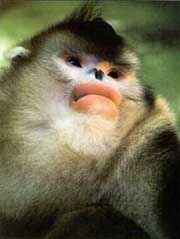With the aliases of Black Golden Monkey, Black Snub-nosed Monkey and Snow Monkey, it belongs to the Cercopithecidae family of Pimates order. Its scientific name is Rhinopithecus bieti (Latin), or Yunnan Snub-nosed Monkey, or Black Snub-nosed Monkey (English).
 |
|
The vertices has pointed black crest. The periphery of the eyes and mouth-nasal part are steel gray or cuticolor, with dark blue nose. The hair color is comparatively monotonous, with the back, body sides, and outer sides of four limbs and tail all in brownish gray or grayish black. Its hair length is up to 23 centimeters. The larynx, neck, inner sides of upper limbs, and hips are white, the chest is milky white and the belly is saffron yellow. The shoulder of male monkey has deep gray-black long hair drooping like coir raincoat. The hip, with obvious spots, has white long hair. The tail hair is long and fluffy. The hair colors of male and female are similar, but the female is comparatively smaller than the male with hair comparatively shorter.
It is distributed in areas of the highest elevation among all kinds of Chinese primates, inhabiting in mixed broadleaf-conifer forests at an elevation of 3,500 to 4,000 meters. In the daytime, it moves about in groups, and rests at noon when the air temperature is high. It mainly feeds on leaves of fir and spruce, flower bracts, as well as pinecones, etc. In summer it likes to eat bamboo shoots and delicate bamboo leaves, sometimes birchen sprouts. Fond of living in groups, it has the habit of vertical migration. In winter it gets down to the places at lower elevation for moving about. Oestrus occurs from June to December every year, and littering is from January to June. Gestation period is about 189 to 198 days, with one baby per fetus.
Found in northwestern Yunnan Province, southwestern Tibet Autonomous Region, it is a species endemic to China, with a narrow distribution. Each natural population is distributed in island shape, isolated from one another. In comparatively concentrated distribution areas, such as Baima Snow Mountain, Haba Snow Mountain and Yanjing, natural protection areas have been established. The stock on hand is estimated to be 1,000 to 1,500.
It has been listed in Appendix I ofInternational Trade Convention on Endangered Wild Animal and Plant Species.
